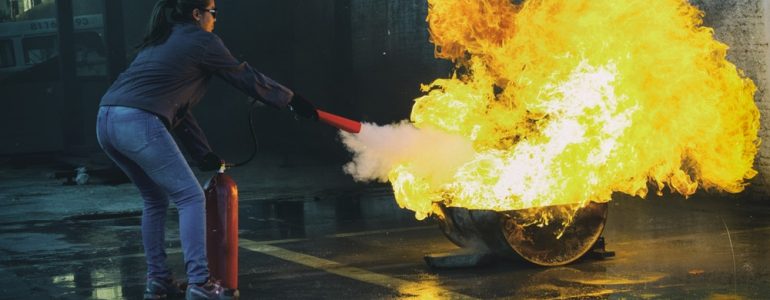Most home fires do not start from big explosions caused by cooking gas or some other highly flammable substance.
They begin as small fires that quickly spread throughout the house.
A candle placed in the wrong place, an overloaded electrical circuit, a smouldering cigarette on the sofa – all these cause dozens of fires every year.
Accidents happen. It’s impossible to completely prevent a fire from starting. But with the right measures, you can prevent it from spreading and causing devastation and injury or even loss of life. So how to prevent fire from spreading?
Here are the most effective ways to prevent a fire from spreading.
1. Get a smoke alarm
In some cases, small fires turn into major tragedies because no one noticed it on time.
Having a smoke alarm in all rooms gives you an early warning so that you can put out the fire (if it’s small) or call fire services.
In addition to installing a smoke detector in all rooms, apart from the bathroom, you should also have one in each hallway as well as the stair landings if you have a multi-storey house.
For extra protection, consider buying one of those smart smoke alarms that also notify you on your phone when they detect smoke or fire. This is helpful when you are away from home.
Others like the Nest smoke detector have voice alarms. They’ll tell you what the problem is and where it is coming from. This allows you to take quicker safety measures.
2. Keep a fire extinguisher on hand
A smoke detector is not much help if you cannot put out a small fire. In the few minutes it takes for fire services to arrive, your home will likely be completely engulfed by flames.
It’s a good idea to always have a fire extinguisher on hand and train everyone in the house on how to use it.
It can make all the difference between a small harmless fire in the kitchen to a catastrophic fire that razes down your home.
You can also get a fire blanket to put out small fires. The blanket smothers the flames, putting them out before they spread.
Keep the blanket in high-risk areas, typically the kitchen.
3. Have a fire-resistant home interior
A couple decades ago, you could have safely escaped a house fire up to 15 minutes after it had started. Nowadays, you have 3 minutes at most.
Modern homes are more flammable. The materials we use for furniture, upholstery and furnishings are to blame.
Most of them are synthetic and have little to no fire resistance.
In addition to burning fast, they also release a lot of heat. This accelerates the speed at which other items catch fire.
To slow down the spread of fire in your home, create a fire-resistant interior.
Start with fabrics – this includes curtains, rugs and upholstery. Look for fire retardant materials that take time to catch fire and burn slower.
Next, either change your furniture to one that is more fire resistant or apply a fire-resistant finish to your current furniture.
It’s not just the furniture and furnishings; things like your interior paintwork and ceiling material also determine how quickly a fire spreads.
Also check your home’s arrangement. Having furniture too close together makes it easy for fire to jump from one point to another.
Avoid placing furniture near electrical outlets and fire or heat sources.
4. Declutter your home
Clutter in your home is a major fire risk. It can propel a small flame or even just sparks into a huge fire.
Having piles of boxes, newspapers, old clothes, old furniture and other odds and ends in the attic, basement, the patio or an unused room makes it easier for fire to spread.
Every few months, go through your home decluttering all the rooms.
Sell or give away what you don’t use. For damaged or worn out items, find a way to dispose them safely.
In addition to making a fire spread faster, clutter can also block escape paths during a fire especially when it’s smoky and you cannot see clearly.
5. Learn how to put out different types of fires
If the fire has already spread to a substantial portion of the room (e.g. it has engulfed the entire sofa or it is going up the curtains), do not attempt to put it out.
House fires spread incredibly fast. You may have just a couple of minutes for you and your family to get out of the house and call fire services.
But for smaller fires, you can put it put yourself before it spreads. But it’s important that you employ the right technique. Otherwise, you might make things worse.
Here’s how to put out different types of fires.
- If it is a microwave or oven fire, just turn off the appliance and close the door. The fire will likely die down on its own. If it takes some time to die or seems to be getting bigger, carefully open the door and spray with a CO2 fire extinguisher.
- If the fire starts in a skillet or pan, close it with a lid. The lack of oxygen will extinguish the fire. But keep your fire extinguisher nearby.
- For grease and oil fires, use a fire blanket or spray with a chemical or foam fire extinguisher. You can also pour baking soda or salt on the fire. Do not use water or a water fire extinguisher as it can worsen the fire.
- If fabric or paper catches fire, dousing the flames with water works well. You can also use a water or foam extinguisher.
- For electrical fires from an appliance or gadget, disconnect it from power then spray with a dry powder or carbon dioxide fire extinguisher. However, for electrical fires where the source is not immediately clear, do not attempt to put it out. Get your family out of the house and call for help.







